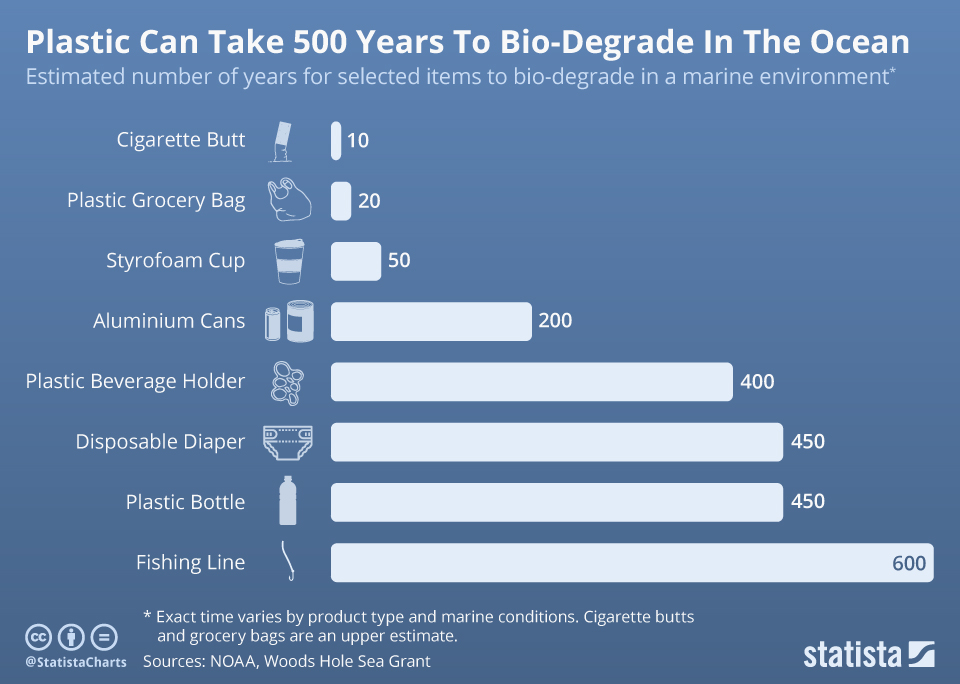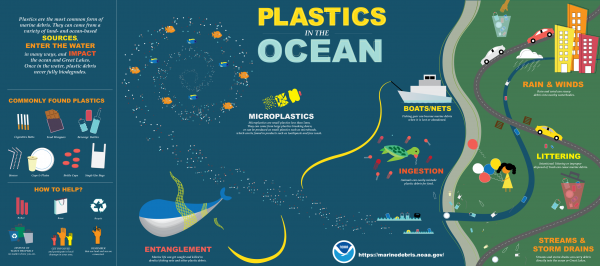The Case for Environmentally Friendly Plastic
Plastic is found in every ocean in the world, on one hand because many countries lack proper plastic waste management infrastructure, and on the other because it stands up extremely well to harsh marine environments. The problem is growing worse with time since more is continually added but seldom is any removed or disintegrated. Calculations by the World Economic Forum predict that by 2050, the plastic in the ocean will outweigh the fish! This is a huge problem for marine life that can get tangled up in it or even mistake it for food and ingest it.

Image credit: Statista
Plastic can obviously be harmful to the planet – but there’s more to the story.
It is clear (unlike those oceans) that filling our oceans with plastic is damaging to marine life and their environment. Fortunately, people are waking up to the issue. Since a lot of this plastic waste comes from food packaging, it is only natural that, in an effort to be more environmentally friendly, many people are doing their best to limit their use of it.
While that intention is admirable, we may need to look at it from another perspective.
People tend to think that we shifted to using more plastic packaging just because it’s cheaper. It is cheaper, but there are other good reasons we started relying more on plastic packaging, namely:
- It’s durable and provides protection from contaminants and the elements.
- It reduces food waste by preserving food and increasing shelf life.
- It’s thin and lightweight which lowers emissions since it doesn’t appreciably add volume or mass to transport.
The overall environmental impact of plastic is lower than alternative materials, like bulky cardboard and weighty metal.
- Plastic packaging serves to contain and preserve food during storage and transportation.
- It seals food away from the external environment so it’s protected from outside elements like pests, microbes and humidity. Without this protection, food is more likely to get damaged and become unusable.
Since plastic can be designed to be durable without becoming heavy, you don’t have to transport a lot of extra mass and volume. That means you reduce fuel consumption, which saves money and lowers emissions that are harmful to the environment.
The judicious use of plastic packaging preserves food during transportation, increases its shelf life, reduces food loss and food waste, and can act as a medium to provide information on proper storage, handling and preparation. Since food waste contributes to climate change, water and energy consumption, deforestation, and biodiversity loss, it’s easy to see that every effort we make to mitigate those effects makes a big difference – and plastic packaging helps make it possible.
In 2017, Denkstatt, a sustainability consultancy that has been analyzing efficiency and energy flows since 1993, published a study called How Packaging Contributes to Food Waste Prevention. According to their findings, “Even if improved packaging solutions contribute to increased CO2 emissions, the CO2 savings from reduced food waste are in most cases much higher.” The study assumed that none of the packaging would be recycled, but if it were then the carbon dioxide reduction would be even greater.
What are the sources of marine plastic pollution and how can we reduce them?
Plastic enters the ocean via many different routes, as shown in the U.S. National Oceanic and Atmospheric Administration graphic below. Proper disposal of plastic items (especially recycling, when possible) is clearly the key to keeping it out of the ocean.

Image credit: NOAA
Although consumers in industrialized countries produce the most plastic waste, developing countries are the source of most of the plastic waste that ends up in the ocean. The best way to help the environment is to improve recycling and waste management throughout the world – particularly in countries where existing infrastructure is lacking.
The UN has launched campaigns such as the World Conservation Monitoring Centre and the Climate Resilience Initiative A2R in an effort to define and address ecological issues in developing areas.
At Torus Pak®, we’re already taking our responsibility seriously and duty to preserve the environment one step further.
Overall, plastic packaging is a better alternative for the environment than glass, metal or other packaging alternatives – but even so, some options are better than others. In an effort to create the most environmentally friendly ready-meal packaging solution, our engineering team evaluated different options for the optimum plastic polymer to use in the Torus Pak®.
In a study of twelve different polymers, polypropylene ranked #1 in life cycle analysis, which is a tool to compare the environmental impact of packaging production, use and disposal. That’s why we use polypropylene in our Torus Pak®.
Plastic food packaging helps to reduce emissions. Plastic waste handling is an environmental issue that needs to be addressed.
In an age where threats to the environment are widespread, it is important for individuals and industries alike to make an effort to minimize the negative environmental impact of their activities. Plastic food packaging reduces food waste and lowers carbon emissions – both of which contribute to a reduction in global warming.
Contact Info:
For further enquiries, contact us at europe@toruspak.com
For the latest updates on Torus Pak®, follow us on LinkedIn

 News, press & videos
News, press & videos